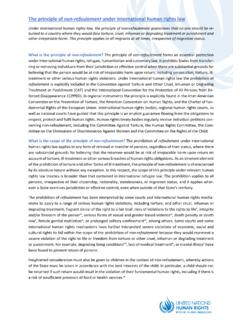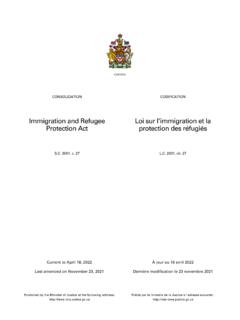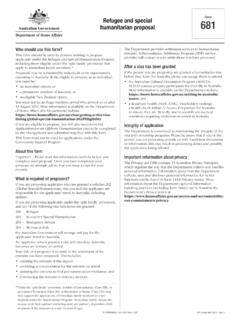Transcription of Non-refoulement and the Scope of its Application - UNHCR
1 Advisory Opinion on the Extraterritorial Application of Non-refoulement Obligations under the 1951 Convention relating to the Status of refugees and its 1967 Protocol* Introduction 1. In this advisory opinion, the Office of the United Nations High Commissioner for refugees ( UNHCR ) addresses the question of the extraterritorial Application of the principle of Non-refoulement under the 1951 Convention relating to the Status of Refugees1 and its 1967 2. Part I of the opinion provides an overview of States Non-refoulement obligations with regard to refugees and asylum-seekers under international refugee and human rights law. Part II focuses more specifically on the extraterritorial Application of these obligations and sets out UNHCR s position with regard to the territorial Scope of States Non-refoulement obligations under the 1951 Convention and its 1967 Protocol. 3. UNHCR has been charged by the United Nations General Assembly with the responsibility of providing international protection to refugees and other persons within its mandate and of seeking permanent solutions to the problem of refugees by assisting governments and private As set forth in its Statute, UNHCR fulfils its international protection mandate by, inter alia, [p]romoting the conclusion and ratification of international conventions for the protection of refugees , supervising their Application and proposing amendments thereto.
2 4 UNHCR s supervisory responsibility under its Statute is mirrored in Article 35 of the 1951 Convention and Article II of the 1967 Protocol. 4. The views of UNHCR are informed by over 50 years of experience supervising international refugee instruments. UNHCR is represented in 116 countries. It provides guidance in connection with the establishment and implementation of national procedures for refugee status determinations and also conducts such determinations under its own mandate. UNHCR s interpretation of the provisions of the 1951 * This Opinion was prepared in response to a request for UNHCR s position on the extraterritorial Application of the Non-refoulement obligations under the 1951 Convention Relating to the Status of refugees and its 1967 Protocol. The Office s views as set out in the Advisory Opinion are offered in a broad perspective, given the relevance of the legal questions involved to a variety of situations outside a State s national territory.
3 1 The 1951 Convention relating to the Status of refugees , 189 137, entered into force 22 April 1954 [hereinafter 1951 Convention ]. 2 The 1967 Protocol relating to the Status of refugees , 606 267, entered into force 4 October 1967 [hereinafter 1967 Protocol ]. 3 See: Statute of the Office of the United Nations High Commissioner for refugees , Res. 428(V), Annex, Doc. A/1775, para. 1 (1950). 4 Id., para. 8(a). Convention and 1967 Protocol is considered an authoritative view which should be taken into account when deciding on questions of refugee law. I. Non-refoulement OBLIGATIONS UNDER INTERNATIONAL LAW A. The Principle of Non-refoulement Under International Refugee Law 1. Non-refoulement Obligations Under International Refugee Treaties (i) The 1951 Convention Relating to the Status of refugees and its 1967 Protocol 5. The principle of Non-refoulement constitutes the cornerstone of international refugee protection .
4 It is enshrined in Article 33 of the 1951 Convention, which is also binding on States Party to the 1967 Article 33(1) of the 1951 Convention provides: No Contracting State shall expel or return ( refouler ) a refugee in any manner whatsoever to the frontiers of territories where his [or her] life or freedom would be threatened on account of his [or her] race, religion, nationality, membership of a particular social group or political opinion. 6. The protection against refoulement under Article 33(1) applies to any person who is a refugee under the terms of the 1951 Convention, that is, anyone who meets the requirements of the refugee definition contained in Article 1A(2) of the 1951 Convention (the inclusion criteria)6 and does not come within the Scope of one of its exclusion Given that a person is a refugee within the meaning of the 1951 Convention as soon as he or she fulfills the criteria contained in the refugee definition, refugee status determination is declaratory in nature.
5 A person does not become a refugee because of recognition, but is recognized because he or she is a It follows that the principle of Non-refoulement applies not only to recognized refugees , but also to 5 Article I(1) of the 1967 Protocol provides that the States Party to the Protocol undertake to apply Articles 2 34 of the 1951 Convention. 6 Under this provision, which is also incorporated into Article 1 of the 1967 Protocol, the term refugee shall apply to any person who owing to a well-founded fear of being persecuted for reasons of race, religion, nationality, membership of a particular social group or political opinion, is outside the country of his [or her] nationality and is unable or, owing to such fear, unwilling to avail him [or her]self of the protection of that country; or who, not having a nationality and being outside the country of his [or her] habitual residence is unable or, owing to such fear, unwilling to return to it.
6 7 Exclusion from international refugee protection means denial of refugee status to persons who come within the Scope of Article 1A(2) of the 1951 Convention, but who are not eligible for protection under the Convention because - they are receiving protection or assistance from a UN agency other than UNHCR (first paragraph of Article 1D of the 1951 Convention); or because - they are not in need of international protection because they have been recognized by the authorities of another country in which they have taken residence as having the rights and obligations attached to the possession of its nationality (Article 1E of the 1951 Convention); or because - they are deemed undeserving of international protection on the grounds that there are serious reasons for considering that they have committed certain serious crimes or heinous acts (Article 1F of the 1951 Convention).
7 8 See: UNHCR , Handbook on Procedures and Criteria for Determining Refugee Status, 1979, Reedited Geneva 1992, para. 28. 2 those who have not had their status formally The principle of Non-refoulement is of particular relevance to asylum-seekers. As such persons may be refugees , it is an established principle of international refugee law that they should not be returned or expelled pending a final determination of their status. 7. The prohibition of refoulement to a danger of persecution under international refugee law is applicable to any form of forcible removal, including deportation, expulsion, extradition, informal transfer or renditions , and non-admission at the border in the circumstances described below. This is evident from the wording of Article 33(1) of the 1951 Convention, which refers to expulsion or return ( refoulement ) in any manner whatsoever .10 It applies not only in respect of return to the country of origin or, in the case of a stateless person, the country of former habitual residence, but also to any other place where a person has reason to fear threats to his or her life or freedom related to one or more of the grounds set out in the 1951 Convention, or from where he or she risks being sent to such a 8.
8 The principle of Non-refoulement as provided for in Article 33(1) of the 1951 Convention does not, as such, entail a right of the individual to be granted asylum in a particular It does mean, however, that where States are not prepared to grant asylum to persons who are seeking international protection on their territory, they must adopt a course that does not result in their removal, directly or indirectly, to a place where their lives or freedom would be in danger on account of their race, religion, nationality, membership of a particular social group or political As a general rule, in order to give effect to their obligations under the 1951 Convention and/or 1967 Protocol, States will be required to grant individuals seeking international protection access to the territory and to fair and efficient asylum 9 This has been reaffirmed by the Executive Committee of UNHCR .
9 For example, in its Conclusion No. 6 (XXVIII) Non-refoulement (1977), para. (c) (reaffirming the fundamental importance of the principle of Non-refoulement .. of persons who may be subjected to persecution if returned to their country of origin irrespective of whether or not they have been formally recognized as refugees . ). The UNHCR Executive Committee is an intergovernmental group currently consisting of 70 Member States of the United Nations (including the United States) and the Holy See that advises the UNHCR in the exercise of its protection mandate. While its Conclusions are not formally binding on States, they are relevant to the interpretation and Application of the international refugee protection regime. Conclusions of the Executive Committee constitute expressions of opinion which are broadly representative of the views of the international community.
10 The specialized knowledge of the Committee and the fact that its conclusions are reached by consensus adds further weight. UNHCR Executive Committee Conclusions are available at (last visited on 26 October 2006). 10 The meaning of the terms expel or return ( refouler ) in Article 33(1) is also discussed infra at Part 11 See: UNHCR , Note on Non-refoulement (EC/SCP/2), 1977, para. 4. See also P. Weis, The Refugee Convention, 1951: The Travaux Pr paratoires Analysed with a Commentary by Dr. Paul Weis, Cambridge University Press, Cambridge (1995), at p. 341. 12 See: P. Weis, supra footnote 11, at p. 342. 13 This could include, for example, removal to a safe third country or some other solution such as temporary protection or refuge under certain circumstances. See E. Lauterpacht and D. Bethlehem, The Scope and content of the principle of Non-refoulement : Opinion , in E.














